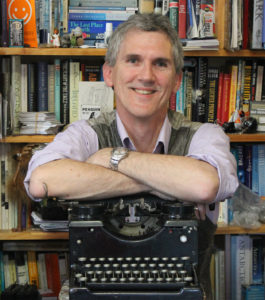In welche Gruppen kann „die Öffentlichkeit“ unterteilt werden? Wie können wir diese Gruppen ansprechen? Und was denken sie über Wissenschaft? Arwen Cross befragte den australischen Wissenschaftskommunikator Craig Cormick.
Who is „The Public“ and how can we communicate with them better?
Die Öffentlichkeit soll sich für wissenschaftlichen Themen stärker interessieren! Stimmt das? Vielleicht lädt der Begriff die Öffentlichkeit zu Verallgemeinerungen ein. Wenn wir besser kommunizieren wollen, müssen wir die Öffentlichkeit (und ihre Teilöffentlichkeiten) besser verstehen und nicht pauschalisieren. So die Aussage von Dr Craig Cormick, Vorsitzender der ASC Conference im folgenden Interview. Wie im vorhergehenden Beitrag mit Joanna Huxster, haben wir auch ihn über den Zusammenhang zwischen vorhandenen wissenschaftlichen Grundkenntnissen und Vertrauen in die Wissenschaft befragt.
Understanding what “The Public” thinks about science
GMOs, atomic power and climate change are all issues that scientists and the public tend to see very differently and people don’t always trust scientific evidence about them. Unfortunately, giving people more information doesn’t help change their minds, in fact it often makes people more entrenched in their opinions through processes like confirmation bias and motivated reasoning, as Joanna Huxster explained in a previous article. Her research offers a glimmer of hope that communicating about how the science system works, rather than about facts or methods alone, might be a way to build trust in science.
So why doesn’t the public trust scientists on certain issues? And who is “The Public” anyway? Does everyone who distrusts science have the same motivation, or is there something more complicated going on? We spoke with Craig Cormick about the many subgroups that make up “The Public” and how to develop strategies for communicating with them.

Dr Craig Cormick is a science communicator who researches public attitudes to science and new technologies in Australia. At the ASC Conference he presented a workshop on engaging with audiences who are not engaged with science. In this interview he explains how different groups of people see science differently and describes some of the groups he found in Australia. He proposes communication strategies that are useful for reaching different audiences, especially those who are disengaged with science.
Why do you think it’s important for us to understand public attitudes to science and new technologies?
It is too easy to just think of the public as “The Public”, and that leads to stereotypes and over-simplification e.g. “The Public” just don’t understand scientists enough, or “The Public” should read wissenschaftskommunikation.de more. But of course we are not all one people. We can divide ourselves by many differences, genders or ages or race or education or languages spoken, or even attitudes. For instance, there are many people who strongly support science and there are some who are very suspicious of it. There are some who would like to understand science more if they had more time, and there are some who find they are too busy to really care about it. And so on.
If we take any contentious science, like GMOs or nanotechnology or climate change, we can divide people by their attitudes and tailor communication strategies to best align with those attitudes. We can also see that simple polls such as what percentage of the population don’t trust vaccinations – don’t really give us the information we need – when we really need to know what percentage of those are women or mothers, or dads, or attend alternative schools, or don’t trust the government or big pharma, and how those with more individualistic values over communal values can easily conclude that putting their child at a very small risk of side-effects to vaccination, for greater community good, is not a preferred deal. This will lead to some capacity to understand where their attitudes come from, and then how to reach them. It won’t be by talking the facts of vaccination, it will more likely be through talking about trust in government and reasons for not trusting big pharma etc…
In general, I find that many science communication strategies aim at those who are already strong supporters, and don’t aim enough at those who are more reluctant, or unaware.

You have studied Australian’s attitudes to science. What range of attitudes did you see? Were there distinct groups?
There are six distinct groups by attitudes and four distinct groups by values. This is important to understand when you are seeking to communicate with people, as it is values that lead to attitudes, and trying to communicate by understanding people’s attitudes is not as effective as communicating by understanding their values.
Grouped according to values, we can break the Australian population into four segments, each making up around 20% of the population1. The groups are:
Segment 1 (20%) – the concerned and disengaged: Segment 1 was the least enthusiastic about the benefits of science and technology. They had the highest agreement that “the pace of technological change is too fast to keep up with” and were the most likely to agree that “science and technology creates more problems than it solves”, that “scientific advances tend to benefit the rich more than the poor”, and that “we rely too much on science and not enough on faith”.
Segment 2 (23%) – the risk averse: This segment tended to be less positive towards the benefits of science and technology generally, and biotechnology specifically. They were also more concerned with related risks. But in contrast to Segment 1, they had relatively high awareness of the term “biotechnology” and various biotechnological applications. They were least likely to agree that “human activities have a significant impact on the planet” and least likely to agree that “not vaccinating children puts others at risk”.
Segment 3 (28%) – the cautiously keen: Segment 3 was defined by relatively high interest in science and agreement that “the benefits of science are greater than any harmful effects”. In relation to GMOs, this segment was the second most positive. While awareness of biotechnology was relatively high for Segment 3 they, like Segment 1, had relatively low levels of self-reported knowledge. They also had the highest agreement that “children should be protected from all risks”.
Segment 4 (23%) – the science fans: This group was the most positive towards science and technology. They expressed greater agreement that “science is such a big part of our lives that we should all take an interest”, that “new technologies excite me more than they concern me” and that “the benefits of science are greater than any harmful effects”. Equally, there was disagreement that “science and technology creates more problems than it solves” and that “we depend too much on science and not enough on faith”.
The public and scientists often see science very differently. How does this affect their attitudes to the risks of new technologies?
Enormously. I summarise the difference as Scientific Risk = Probability x Impact, and Public/s Risk = OMG x WTF?
If I were given to generalising I’d say that scientific views of risk are more driven by data and evidence and public/s views of risk are more driven by perception and emotion. We know that people believe flying on an airplane is riskier than it actually is, and believe that smoking is less risky than it actually is. There is a natural tendency for many people to either overplay or underplay risk, and rather than tell them, “Here is the data. This is how we think of risk and this is how you should think of risk!” – you should find what factors drive those perceptions of risk (e.g. single incidents, lack of known impacts etc) and engage on those factors, and wait for them to ask for the data.
What strategies can science communicators use to overcome these differences when communicating about new technologies?
The six things I recommend keeping in mind when communicating science are:
- When information is complex, people make decisions based on their values and beliefs.
- People seek affirmation of their attitudes (or beliefs) – no matter how fringe – and will reject any information or facts that are counter to their attitudes (or beliefs).
- Attitudes that were not formed by logic are not influenced by logical arguments.
- Public concerns about contentious science or technologies are almost never about the science – and scientific information therefore does little to influence those concerns.
- People don’t care what you know – they want to know that you care.
- People most trust those whose values mirror their own
In short, if you can determine a person’s values, you can frame your communication to align with their values and have much greater chance of reaching them.
You would probably categorise most science communicators as “science fans”. What do we need to be careful about when communicating with people who are much less interested in science?
We found that the Fan Boys and Fan Girls were further away from the community average than any of the other segments, which means those people working in science and technology are not just at risk of group-think, but can have as much difficulty understanding the perspectives and values of the other segments as the other segments have of understanding them.
Get out and find those other segments and talk to them and listen more than you talk and try and really understand what is driving their attitudes – and ideally get them to codesign your communications strategies – then you will have some hope of reaching them.
Want some more reading on these ideas? Check out these articles.
Gastbeiträge spiegeln nicht zwangsläufig die Meinung unserer Redaktion wider.
kurz & knapp
- Wir müssen die diversen Gruppen, die unter “Öffentlichkeit” zusammengefasst sind, besser verstehen, um besser mit ihnen kommunizieren zu können
- Eine Kommunikationsstrategie, die dem Vertrauensverlust in wissenschaftlichen Fakten entgegnen soll, soll auch dessen Ursachen und vor allem seine Folgen bekämpfen
- Das individuelle Verhältnis zu Risiken ist sehr wichtig für die Beziehung zur Wissenschaft.
- Wissenschaftler haben ein anderes Verhältnis zum Risiko als die durchschnittliche Bevölkerung – wer das berücksichtigt, kommuniziert besser.







